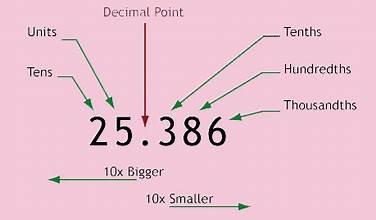DECIMALS
Decimals are a numerical representation of a real number, typically written in base 10. They consist of a whole number part and a fractional part separated by a decimal point. The decimal point is used to indicate the boundary between the whole number and the fractional part.
For example, in the decimal 3.14159, “3” is the whole number part, and “14159” is the fractional part. The number after the decimal point represents fractions of powers of 10, such as tenths, hundredths, thousandths, and so on.
Here’s a breakdown of the place values in a decimal:
- Tens place (10): 3.14159 (3 is in the tens place)
- Ones place (1): 3.14159 (1 is in the ones place)
- Tenths place (1/10): 3.14159 (4 is in the tenths place)
- Hundredths place (1/100): 3.14159 (1 is in the hundredths place)
- Thousandths place (1/1000): 3.14159 (5 is in the thousandths place)
- Ten-thousandths place (1/10,000): 3.14159 (9 is in the ten-thousandths place)
Decimals are used in various mathematical operations, including addition, subtraction, multiplication, and division. They are a fundamental part of everyday calculations and are widely used in fields such as finance, science, engineering, and more.
DECIMAL NUMBER TO BINARY
Converting a decimal number to binary involves representing the decimal number in base 2, where only the digits 0 and 1 are used. Here’s a step-by-step process to convert a decimal number to binary:
Let’s use the decimal number 25 as an example:
- Start with the decimal number: 25
- Divide the number by 2:
- 25 ÷ 2 = 12 with a remainder of 1
- Write down the remainder (1) as the rightmost digit in your binary representation:
- Binary so far: 1
- Continue dividing the quotient (12) by 2:
- 12 ÷ 2 = 6 with a remainder of 0
- Write down the remainder (0) to the left of the previous binary digit:
- Binary so far: 01
- Continue dividing the new quotient (6) by 2:
- 6 ÷ 2 = 3 with a remainder of 0
- Write down the remainder (0) to the left of the previous binary digits:
- Binary so far: 001
- Again, divide the new quotient (3) by 2:
- 3 ÷ 2 = 1 with a remainder of 1
- Write down the remainder (1) to the left of the previous binary digits:
- Binary so far: 1001
- Finally, when the quotient becomes 1, write it down as the leftmost digit:
- Binary: 11001
So, the decimal number 25 in binary is 11001.
You can use this method to convert any decimal number to its binary representation. Each division by 2 produces a binary digit, with the remainders being written down from right to left to form the binary representation.
OCTAL TO DECIMAL NUMBER
Converting an octal number (base 8) to decimal (base 10) involves multiplying each digit in the octal number by the corresponding power of 8 and then summing the results. Here’s a step-by-step process to convert an octal number to decimal:
Let’s use the octal number 345 as an example:
- Start with the octal number: 345
- Write down the powers of 8 from right to left:
- The rightmost digit corresponds to 8^0 (1)
- The next digit to the left corresponds to 8^1 (8)
- The leftmost digit corresponds to 8^2 (64)
- Multiply each octal digit by the corresponding power of 8:
- 5 * 8^0 = 5 * 1 = 5
- 4 * 8^1 = 4 * 8 = 32
- 3 * 8^2 = 3 * 64 = 192
- Sum the results:
- 5 + 32 + 192 = 229
So, the octal number 345 in decimal is 229.
You can use this method to convert any octal number to its decimal representation by multiplying each octal digit by the corresponding power of 8 and summing the results.
CONVERTING DECIMAL TO FRACTION
Converting a decimal to a fraction involves expressing the decimal number as a ratio of two integers, where the numerator is the decimal number itself, and the denominator is a power of 10 to represent the decimal’s place value. Here’s a step-by-step process to convert a decimal to a fraction:
- Identify the Decimal: Start with the decimal number you want to convert. For example, let’s say you want to convert 0.75 to a fraction.
- Count the Decimal Places: Count the number of decimal places in the decimal number. In the case of 0.75, there are two decimal places.
- Write the Decimal as a Fraction: Write the decimal number as the numerator of a fraction. For example, for 0.75, the numerator is 75.
- Determine the Denominator: The denominator is determined by the number of decimal places. For each decimal place, you use a power of 10 in the denominator. Since there are two decimal places, the denominator will be 10^2, which is 100.
- Simplify the Fraction: If possible, simplify the fraction by dividing both the numerator and denominator by their greatest common divisor (GCD). In this case, the GCD of 75 and 100 is 25, so you can simplify the fraction as follows:
(75 ÷ 25) / (100 ÷ 25) = 3/4
So, 0.75 can be expressed as the fraction 3/4.
In general, to convert a decimal to a fraction:
- Identify the decimal.
- Count the decimal places.
- Write the decimal as the numerator.
- Determine the denominator using powers of 10.
- Simplify the fraction if possible.
